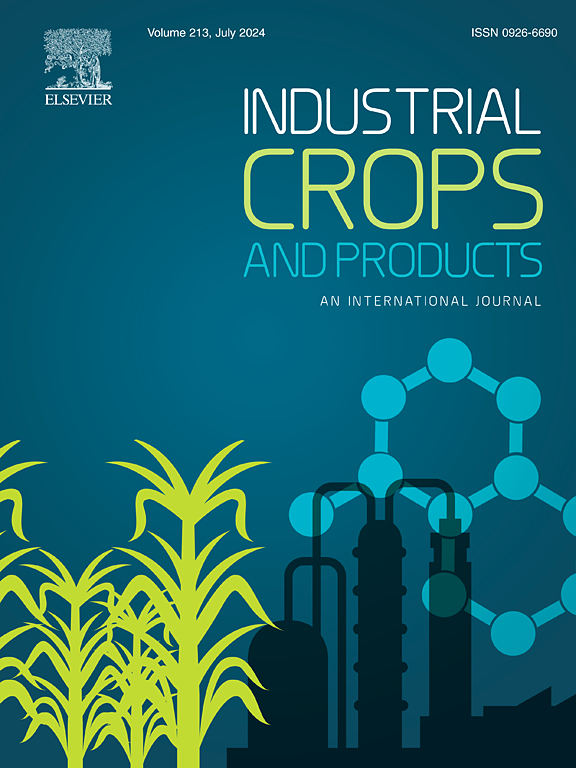Rain-fastness and puncture resistance of biodegradable horticultural hydromulches
IF 5.6
1区 农林科学
Q1 AGRICULTURAL ENGINEERING
引用次数: 0
Abstract
In horticultural production, mulching is vital for suppressing weeds, optimizing the soil micro-climate, and promoting crop growth. Traditional polyethylene-based mulches, despite its effectiveness, poses environmental challenges due to poor recyclability and persistence in ecosystems. Biodegradable hydromulches (HM), composed primarily of cellulosic materials and tackifiers, offer a sustainable alternative. This study evaluated various HM formulations to identify those with optimal moisture resistance through rain-fastness index measurement and puncture resistance. Formulations incorporated fibrous materials, such as paper, wood fiber, hemp hurds, or combinations thereof, blended with tackifiers—guar gum, psyllium husk, or camelina meal at 2 %, 4 %, or 6 % concentrations. Moisture characteristics were assessed for puncture resistance at four moisture levels, 0 %, 50 %, 75 %, and 100 % and rain-fastness. Puncture resistance was measured as the pressure level at which a flat 13.7 mm diameter probe ruptured the formulation. Rain-fastness, a measure of the resistance to material loss under simulated rain, was calculated as the ratio of weight of HM before and after rain-fastness tests. Results showed HM puncture resistance decreased significantly with increased moisture, dropping below 0.50 MPa at 50 % moisture content. Rain-fastness and following puncture resistance tests indicated that paper-based HMs resisted disintegration better than wood fiber-based ones, achieving a higher rain-fastness index and up to 67 % increase in puncture resistance compared to wood fiber formulations. Hemp inclusion decreased puncture resistance by 40–70 %, depending on the tackifier. Formulations with psyllium husk maintained higher puncture resistance than those with camelia meal and guar gum. Paper-based HMs had minimal material loss during simulated rainfall, with a rain-fastness index (RFI) of 0.93, superior to wood fiber formulations' RFI of 0.84. Adding hemp increased material loss by 2–4 %. Overall, paper-based HM formulations demonstrated superior performance, with the top formulations containing paper and varying concentrations of guar gum, psyllium husk, and camelina meal. These findings suggest that paper-based HMs are a promising biodegradable alternative suitable for organic farming but require further field testing.
生物可降解园艺水膜的耐雨性和抗刺穿性
在园艺生产中,覆盖对抑制杂草、优化土壤小气候和促进作物生长至关重要。传统的聚乙烯基地膜尽管有效,但由于其在生态系统中的可回收性和持久性较差,对环境构成了挑战。可生物降解水膜(HM),主要由纤维素材料和增粘剂组成,提供了一种可持续的替代方案。本研究评估了各种HM配方,通过测定耐雨指数和抗穿刺性来确定具有最佳抗湿性的配方。配方中含有纤维材料,如纸、木纤维、麻束或其组合,并以2 %、4 %或6 %的浓度与瓜尔胶、车前草壳或亚麻粉等黏合剂混合。在4个湿度水平(0 %、50 %、75 %和100 %)下评估抗穿刺性和耐雨性。穿刺阻力测量为直径为13.7 mm的扁平探针破裂配方时的压力水平。耐雨牢度是衡量材料在模拟雨下抵抗损失的一项指标,通过耐雨牢度试验前后HM的重量之比来计算。结果表明,HM的穿刺阻力随含水率的增加而显著降低,在含水率为50% %时降至0.50 MPa以下。耐雨性和随后的抗刺破性测试表明,纸基HMs比木纤维HMs更能抵抗崩解,具有更高的耐雨性指数,与木纤维配方相比,抗刺破性提高了67% %。麻的加入降低了40-70 %的穿刺阻力,这取决于增粘剂。车前草壳比山茶花粉和瓜尔胶具有更高的抗穿刺性。纸基HMs在模拟降雨过程中材料损失最小,耐雨指数(RFI)为0.93,优于木纤维配方的RFI(0.84)。添加大麻可使材料损失增加2-4 %。总的来说,纸基HM配方表现出优异的性能,顶级配方含有纸和不同浓度的瓜尔胶、车前草壳和亚麻荠粕。这些发现表明,纸基HMs是一种有前途的可生物降解替代品,适用于有机农业,但需要进一步的实地测试。
本文章由计算机程序翻译,如有差异,请以英文原文为准。
求助全文
约1分钟内获得全文
求助全文
来源期刊

Industrial Crops and Products
农林科学-农业工程
CiteScore
9.50
自引率
8.50%
发文量
1518
审稿时长
43 days
期刊介绍:
Industrial Crops and Products is an International Journal publishing academic and industrial research on industrial (defined as non-food/non-feed) crops and products. Papers concern both crop-oriented and bio-based materials from crops-oriented research, and should be of interest to an international audience, hypothesis driven, and where comparisons are made statistics performed.
 求助内容:
求助内容: 应助结果提醒方式:
应助结果提醒方式:


